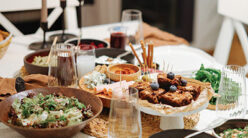If you want to fill your grocery cart with foods that will help keep cancer far from home, start with these powerful foods:
Colorful Fruits & Vegetables
 According to the recent World Cancer Research Fund report, fruits and vegetables are especially protective against cancer of the lung, mouth, esophagus, and stomach. A Swedish study, for example, reported that three or more servings a week of green leafy vegetables significantly reduced the risk of stomach cancer.
According to the recent World Cancer Research Fund report, fruits and vegetables are especially protective against cancer of the lung, mouth, esophagus, and stomach. A Swedish study, for example, reported that three or more servings a week of green leafy vegetables significantly reduced the risk of stomach cancer.
Cabbage, cauliflower, brussels sprouts, and broccoli all help protect against colon cancer and other cancers. (Interestingly, broccoli sprouts are reported to contain 10 or more times as much sulforaphane, a cancer-protective substance, as mature broccoli contains.) Additionally, a higher consumption of green leafy vegetables has been shown to significantly decrease the risk of breast cancer and skin cancer.
Fruits rich in the red pigment lycopene (tomatoes, watermelon, guava, papaya) are reported to protect against prostate cancer. Pomegranates also provide protection against prostate cancer, and blueberries have been shown to suppress colon cancer.
The red, blue, and purple anthocyanin pigments in blackberries, strawberries, raspberries, blueberries, plums, cherries, red grapes, and cranberries protect against cancer. The deeper the color of the fruit, the stronger the protection against colon cancer growth.
Carrots and celery contain compounds that have anti-inflammatory, antibiotic, and anticlotting properties. Additionally, falcarinol, isolated from carrots, has been observed to delay the growth of colon tumors.
Quercetin, a major bioflavonoid found in apples, onions, red grapes, and green leafy vegetables, displays unique anticancer properties and has strong antioxidant and anti-inflammatory activity.
Whole Grains & Legumes
A high intake of whole grains provides substantial protection against various cancers, while the regular use of legumes provides a measure of protection against stomach and prostate cancer. There are an array of healthy whole grains, including whole wheat, brown rice, quinoa, oats, flaxseed, bulgur, and spelt. Legumes also offer a wide variety, from black beans to chickpeas, pinto beans to kidney beans.
Soy
Studies conducted in high-soy-consuming Asians showed a significant correlation between increased soy food intake and decreased breast cancer risk. Among female Chinese breast cancer survivors that were followed for four years, soy food consumption was significantly associated with decreased risk of death and recurrence.
Garlic & Onion
Various studies show that garlic can reduce the risk of stomach, prostate, and colon cancer. Risk of prostate cancer, for instance, was 44 percent lower in those using garlic more than once per week. In China, people with the highest intake of garlic, onions, and leeks had a risk of stomach cancer that was 40 percent lower than people with the lowest intake of those foods. In the Iowa Woman’s Health Study the highest consumption of garlic was associated with a 32 percent reduced risk of colon cancer.
The antitumor property of garlic is largely because of its diverse content of organic sulfides. The inhibition of tumor growth by garlic seems to be effective only when the tumor size is small. More research is needed to actually determine the quantity of garlic needed to minimize cancer risk.
Studies in Greece have shown a high consumption of onions, garlic, and other allium herbs to be protective against stomach cancer. A Dutch study also revealed that stomach cancer for those consuming at least half an onion a day was about 50 percent lower than that in persons consuming no onions.
Turmeric & Ginger
Turmeric provides a rich yellow color when added to foods such as rice and tofu dishes, and can also be used to flavor soups. The yellow-orange color of turmeric is because of curcumin, a bright pigment that is a more powerful antioxidant than vitamin E. Curcumin has the ability to suppress the growth of certain cancers, such as stomach, breast, colon, lung, and skin cancers.
Dried ginger root contains a rich package of antioxidants that possess pronounced anti-inflammatory activity that can also inhibit various cancers. Ginger also contains curcumin, which assists in the elimination of cancer-causing substances from the body.
Ginger can be enjoyed in a variety of ways, including in fruit salads, juices, muffins, or other baked goods.
Flax
Increasingly flaxseed flour is being used in breads, cereals, and bakery products not only to provide a pleasant nutty flavor but also to increase the nutritional benefits. A teaspoon or two of flaxseed flour can even be sprinkled on your morning cereal.
Animal studies have shown that flaxseed in the diet can reduce the incidence of breast tumors by 40 percent and can reduce tumor size of chemically induced cancers by about 50 percent.
The Parsley Family
The herbs of the parsley family—including cilantro, parsley, fennel, caraway, and dill—are a good source of cancer-preventive properties.
Need ideas on how to incorporate the parsley family into your food prep? Cilantro is a great addition to a tomato and lettuce salad, while ground cumin seed is an important part of flavorful hummus. A sprig of parsley adds color and flavor to any soup or vegetable dish. Fennel finds value in a vegetable dish, while dill successfully flavors cucumbers and potato salads. Caraway seeds can be used to flavor breads, baked goods, and stewed fruits; coriander seeds are great in curry powders and pickles.
Mint
The compounds responsible for the flavors of the mints (basil, oregano, thyme, rosemary, sage, spearmint) are terpenoids, which also suppress the growth of tumors and decrease the number of tumors produced.
Ginseng
In a large study in Korea the incidence of human cancer steadily decreased with the length of time Asian ginseng was used. Those who had taken ginseng for one year had 36 percent less cancer than nonusers, while those who used ginseng for five years or more had 69 percent less cancer. In addition, those who had even used ginseng less than 50 times in their life still managed 45 percent less cancer than nonusers, while those who used ginseng more than 500 times in their life had 72 percent less cancer. In reducing the risk of cancer, ginseng extract and powder were found to be more effective than fresh sliced ginseng or ginseng tea.
Winston J. Craig, Ph.D., R.D., is a professor of nutrition at Andrews University in Berrien Springs, Michigan.






